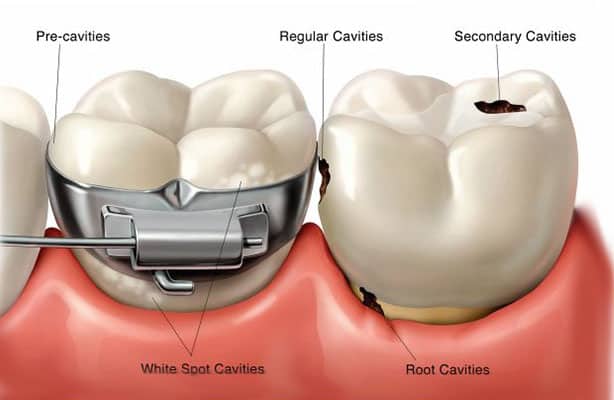
Dental Filling
Dental Filling For cavity treatment
Natural-looking tooth colored composite fillings. Dental fillings are used for cavity treatment whereby tooth decay is first removed and thereafter filled with tooth-colored fillings or amalgam fillings. Kitcha general dentistry clinic is an amalgam-free clinic and uses composite resin for its dental fillings.
Cavity Treatment
When you eat or drink foods with sugars, bacteria in plaque produce acids that can attack tooth enamel. If brushed well and regulary, plaque is kept in check. If plaque is not removed, its stickiness keeps these acids in contact with your teeth. Over time, the enamel of your teeth can break down causing cavities to form.
A cavity or tooth decay is a little hole in your tooth. The hard outer layer of your tooth, or enamel, has been damage. Bacteria can accumulate in tiny crevices of your tooth that causes acid build up which leads to decay.

If a cavity is treated early, you will not likely need extensive treatment.It is recommended to make bi-annual visits to your dentist for a routine dental cleaning in preventing and checking for tooth decay. Dental caries treatment varies with the severity of damage to your tooth starting with:
- Fluoride treatments : fluoride treatment may help restore your tooth enamel if a cavity is in very early stages and can sometimes be reversed.
- Tooth fillings : dental fillings are a type of tooth restorations and is the main treatment option for decay. Tooth cavity filling can be done with composite resins, porcelain or dental amalgams
If your cavity has progressed more extensively, more invasive treatments with dental crowns, root canal treatment or even tooth extraction may be diagnosed by your dentist.
Stages Of Cavities And Types
Stage One Disease: Pre-Cavities
- Tooth loses minerals on the outer surface
- This is usually invisible to the naked eye
- Areas where teeth touch are really vulnerable
Stage Two Disease: White Spots
- White spots are the first visible signs
- They appear near your gum line or near your braces
Stage Three Disease: Cavities
- Part of the healthy tooth is destroyed. It has to be cleared of decay and filled with dental filling
- If the tooth decay gets too deep, this can cause tooth damage, root infection and toothaches
- If not treated at an early stage with simple dental fillings, you may need a crown
- Or if the tooth needs to be removed, the missing gap later replaced with a bridge or dental implant

Types of Cavities
Regular Cavities
- When healthy part of the tooth is damaged, it can be cleared of decay and filled with tooth-colored fillings
- If the decay gets into the tooth root, root canal treatment followed by a crown may be required
- If the root infection is severe, the tooth may need to be removed and replaced with a bridge or dental implant
Root Cavities
- Root cavities start on the tooth surface near the gums. Typically it is faster growing than regular cavities and more common in adults
- Cavities near your root can make your teeth sensitive and painful when you eat, drink cold or hot beverages
- As it is near your root area, it may affect your nerves caue sensititiy and pain
Secondary Cavities
- Secondary cavities usually stem from older fillings that crack or chip over time
- Plaque and bacteria get under them and cause new decay
- These secondary cavities need to be removed. The old filling is normally removed and the whole damaged portion re-fillled with a new fillling or depending extent of damage inlay, onlay or crown.
Tooth Filling Procedure
1. Examination, X-ray and Treatment Plan
Your dentist examines the extent of decay or cavity by looking at your teeth to determine the extent of tooth decay. If your dentist suspects that the tooth cavity may be deeper, a small x-ray may be taken to check that specific tooth. A panoramic x-ray may also be requested to check the prognoses all teeth.
2. Removal of Tooth Cavity
3. Tooth Filling and Polishing

Small X-ray
Peripal X-ray to Check for cavities under gums

Bi-Annual Checkup
To detect early cavities and maintain oral health, a visit to your dentist is recommended every 6 months or as instructed
Dental Filling Faqs
What are my tooth decay treatment option?
The recommended tooth decay treatment option for your case will depend on the extent of your caries. If there are small signs of caries but does not yet warrant a dental filling, fluoride treatment followed by consistent brushing can sometimes reverse the issue. However, if the dental caries has damaged portions of your tooth, then dental fillings may be done. When the size of required dental fillings is large, onlays, inlays or overlays (that are porcelain pieces) may be recommended. Assuming that the tooth decay has further significantly impaired the tooth, a crown may then done to fix the tooth. If the decay has infected the tooth root, root canal treatment would then be required.
Can a dental filling break?
Yes. When you chew, grind or clench, there is constant biting pressure that can cause tooth fillings to wear down, dislodge, chip, or crack. Decay-causing bacteria can work their way under the filling if the seal between the tooth and filling material has crevices.
Can I fix a broken filling?
No. Essentially, you will need to have the old filling removed and a new tooth filling done. It is important to replace damaged or broken filling as soon as you can too avoid bacteria leaking through gaps of the broken filling. If left untreated, infection and more extensive treatment may be required.
How do I know if my fillling is broken?
If your filling is broken or dislodged, you may experience a little pain when the tooth is exposed to the air or hot or cold temperatures. Make an appointment as soon as you can with your dentis. For interim relieve, applying a little dental cement that is available in drug stores can help reduce the sensitivity.
Depending on the type of material used, fillings usually last between seven to 15 years. If your filling is old and showing some signs of wear, it’s best to replace it before it cracks. Symptons that your dental filling may need broken or needs replacement :
1. Your tooth hurts
2. You feel pain when you drink cold beverages
3. The old filling has become darker, slightly yellowish or changed color
4. Part or the full filling has fallen out
5. Your filling is old. Dental filllings can last a long time, if it is 7 to 15 years and shows some signs of wear, it is best to have it checked before it cracks.
How much is dental filling cost?
Dental filling cost varies with the material chosen – amalgam, composite resins, porcelain. In general amalgam fillings are normally the least expensive costing in Thailand about THB800 – 4,000 per tooth (estimated USD$25 -$125 per tooth). Composite resin tooth-colored filling are the preferred and more popular material, its tooth filling price ranges between THB1,000 – 5,000 per tooth (estimated USD$30 – $160) Get a cavilty filling cost estimate at BIDH out-patient dental clinic with a checkup and consult with our general dentist.
I need a front tooth filling. What should I do?
Most individuals expect good aesthetics when requiring a front teeth filling. For this reason, composite resin or tooth-colored fillings will be the recommended or the preferred dental filling material. Your restorative dentist will first assess the chip or damage of your front tooth before determining if simple fillings or dental bonding might be used to treatment the issue. Dental fillings can be completed in 1 visit. If you are planning for your visit, you are able to email us a photo of the concern area. If you are reside in Bangkok, simply call us for an appointment for avoid waiting time. If walking-in to our dental clinic, the next available appointment timeslot will simply be assigned to you.

